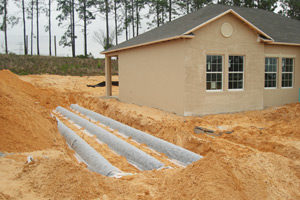Septic Drain Fields are the last stop for wastewater in septic systems. But, that doesn’t mean they aren’t important. In fact, drainfields (also known as leach fields or absorption beds) are responsible for removing contaminants and impurities. A job that’s done utilizing the natural area’s abilities. This final treatment is possible because of the drain field’s design.
Septic Drainfield Design
Drain fields immediately follow the septic tank in septic systems and can only accept liquid wastewater—nothing solid.

The drainfield is made up of a series of perforated pipes, extending like a hand away from the rest of the septic system running parallel to the ground. Typically, these pipes lay on top crushed gravel or stone.
Gravel and stone act as natural filters. Once the wastewater leaves the perforated drainfield pipes, it trickles through the gravel and stone layer—similar to a pasta strainer.
Below the gravel layer, lies the area’s natural soil. As the filtered water trickles through the ground, the last remaining contaminates disappear, eliminated by the filtering granules of dirt and sand.
Finally, the treated wastewater enters the communities’ water table.
Drain Fields are Solid-Free Zones
Drain fields are most definitely solid free zones. Their small perforated pipes are designed only to allow water through. Solids become trapped, blocking the natural flow of the drainfield.
Solids only enter the drainfield due to an unhealthy system. Either an overload of water or grease from the house causes solids entering the drainfield—forcibly pushed out of the septic tank with no space.
On the flip side, excessive rain can leave the soil saturated causing wastewater to be pushed up instead of down. The wastewater leaves the system before it’s final treatment.
What do these situations mean?
Water contamination. Improperly treated wastewater can find its way back to the water table, contaminating the local water supplies. What’s worse? Cracks in your well could mean contaminated drinking water as well.
Florida Drain Field Regulations

Surprise! Drain fields come with rules and regulations. Luckily, professional and licensed septic companies like Advanced Septic Services, know all the rules.
Still curious? Here is the cliff notes version.
- Septic Tanks and Drainfields must be 75 feet from any lakes, bays, surface water, or wells.
- Placement must be 10 feet away from stormwater pipes and drains.
- The drainfield must be 75 feet above/away from the annual flood line or high water line.
Basically, keep the drainfield above high water marks and away from water supplies. That way, wastewater always receives the final round of treatment before re-entering the local water supply.
Tips for Septic Drainfield Owners
Drain fields need a healthy system and a somewhat gentle touch to avoid damage and backups. Here are some tips for any septic drainfield owners.
- When possible, always conserve water. While better for the environment, water conservation leads to less excess in the system, reducing the chances of solids in the drainfield.
- Only landscape with septic and leach field safe plants. Large shrubs and trees, renown for deep, thick roots, destroy drainfields by puncturing pipes and clogging the surrounding soil.
- Never park on the drainfields (or any part of the septic system). Same goes for heavy landscaping pieces, like playgrounds and terraces. Too much weight leads to crushed and deformed drainfields.
- Regularly clean and clear rain gutters and drains, allowing easy, unobstructed passage of rainwater away from the leach field.
Drain fields are an essential, final part of septic systems. Using gravity, they filter out remaining contaminates and imperfections using the natural filtration of gravel, rocks, and soil. Think your drainfield needs a checkup? Call Advanced Septic Services at 352-242-6100 today.

